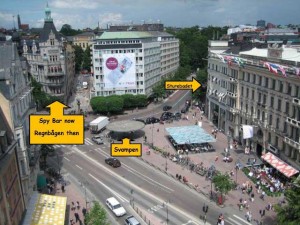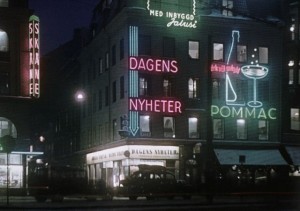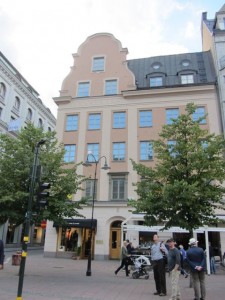10 Feb Stureplan Then and Now
Stureplan is a city square in Stockholm, one of the most popular for the young, hip, and affluent. It is located along the street Birger Jarlsgatan, one of the longest streets in town and where you can find exclusive high-end shops and restaurants.
During World War II my mother Hedvig Johnson stayed just north of Stureplan when she first came to Stockholm in August of 1944 to work for the OSS (Office of Strategic Services.) The address was Stureparken 3, right on a park which, in centuries past, served as a cemetery for the poor and for victims of cholera.
So Hedy would have walked to Stureplan often. For one thing, the public bathhouse, Sturebadet, was located there. Since many of the apartments didn’t have bathing facilities, this was a popular destination. Once she became pregnant (with me!) her doctor told her, “No more massages!”
There was a popular restaurant in the same building that now houses the “Spy Bar.” It just so happens that Regnbågen was a popular meeting place for the Gestapo. The members of the OSS, including my parents, ate there often. I suppose everyone was spying on everyone.
When I went to Stockholm last September (#SiblingsinSweden) I brought with me this 1943 photo of Stureplan, brightly lit with Neon lights. During World War II that would have been quite a sight for the Americans who had just been to London where not even a sliver of light could be seen at night. I wanted to see what the spot looked like today. With some help from Swedish friend Pär, I found it!
Most of the neon signs are gone now. As the vintage buildings were remodeled the signage became more subtle, more professional. I’d love to have feedback from the Stockholmers here. I’m sure there is a “Design Board” that determines what can and can’t be done on the street.
From what I’ve read, it was partly a safety issue. People would pay attention to the signs instead of the traffic! Plus, it probably became a matter of who could do the biggest and the brightest. There are also environmental concerns … high power usage and the possibility of leaking toxic gases.
I love to look at this Stureplan webcam. At night, there are lights on but nothing like it used to be. This article “Street Style: Stureplan” says the high point of the neons was in the 1950s.
The svampen or “mushroom” is the Stureplan icon. It was erected in 1937, right before the war. On this page in the Nyheter24 website is a fabulous photo of Stureplan on May 7, 1945, the day that Germany surrendered. There was merriment everywhere, and my mother was right there marching with the ecstatic Norwegians on her way to one of the restaurants she frequented, Anglais. All her friends from the American Legation met there for a grand celebration. (Anglais is no longer there; the Hotell Scandic Anglais is nearby.)
In addition to the Americans and Norwegians, there were Swedes and Danes, all jammed into the restaurant, dancing and singing.
Hedy even did the jitterbug.





No Comments